Grassland heritage sees new horizons
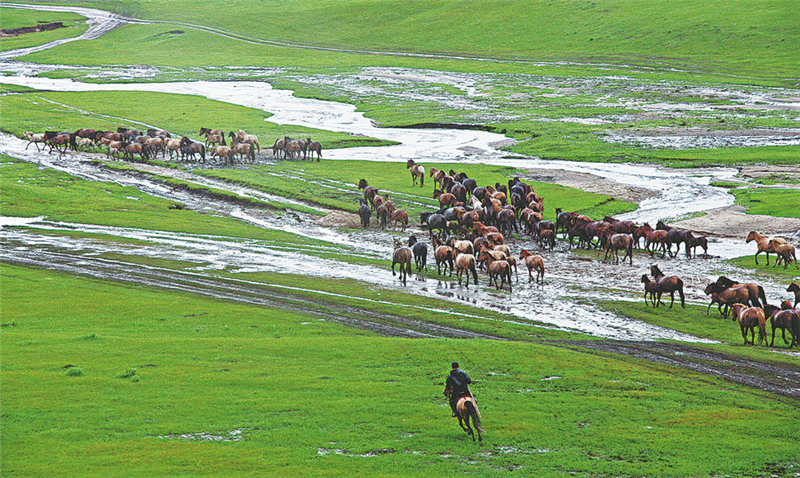
Ar Horqin Grassland Nomadic System in the Inner Mongolia autonomous region, which has been inscribed on the list of Globally Important Agricultural Heritage Systems by the Food and Agriculture Organization of the United Nations, demonstrates the wisdom of herdsmen to work in harmony with nature. [Photo provided to China Daily]
The sun hasn't yet risen, but herdsman Oyunbileg, 39, has got up to prepare for this big day. For locals in Bayan-Undur sum, a township-level administrative division of the Inner Mongolia autonomous region, who have experienced pastoral life and witnessed the circle of nature one generation after another, the mid-June season is among the busiest of the year.
The room is infused with an aroma of dairy, thanks to the heavy Mongolian breakfast prepared by Oyunbileg's wife-milky tea, quark cheese and dried beef-a must before setting off on the journey with his "family". This includes about 70 sheep and goats as well as 30 head of cattle.
The grass is flourishing and lush. Bayan-Undur sum sits in the heart of boundless prairies spreading across Ar Horqin Banner (a county-level administrative region) in Inner Mongolia. To better nurture their livestock, more than 3,000 households of the sum, or about 15,000 people, will move to their summer camps. Just like their ancestors, they will stay there for about three months before returning to the winter settlements.
These three months also enable the grass at the winter camp to restore its lushness, providing the herdsmen with feed for the approaching snowy season.
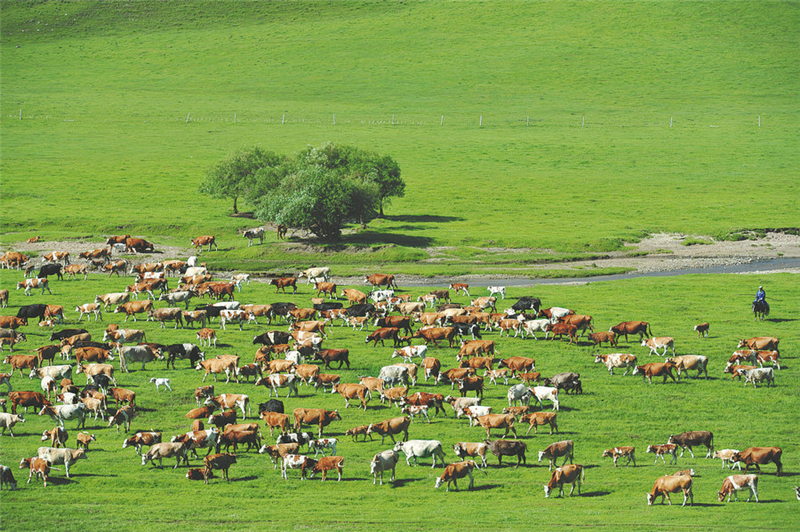
Ar Horqin Grassland Nomadic System in the Inner Mongolia autonomous region, which has been inscribed on the list of Globally Important Agricultural Heritage Systems by the Food and Agriculture Organization of the United Nations, demonstrates the wisdom of herdsmen to work in harmony with nature. [Photo provided to China Daily]
In 1546, the 15th-generation grandson of Genghis Khan's younger brother led his tribe to relocate here, but the nomadic tradition on this land stretches back many more centuries, even further back than the rise of Genghis Khan. Archaeologists have found evidence that people carried out basic production here as far back as the Neolithic Age.
Since Oyunbileg's childhood, summertime journeys have been etched into his memory.
"I first moved around in summer with my parents when I was 7 or 8," Oyunbileg recalls. "It was a really tough journey riding the lele cart (a type of oxcart) for days. It was exhausting, but so much fun."
Throughout history, until around a decade ago, lele carts carried the hopes of locals for robust livestock, which were fed on the flourishing grass. In the past decade, there has been an increase in the use of modern vehicles. A journey now is often shortened from days to hours.
"When we set off with other families, it's sometimes like a group trip, and, driving a van on the road, we don't worry about bad weather anymore," he says. "The yurts we live in are also much better equipped nowadays, with things like solar-powered facilities."
Tools may change, but some key traditions linger.
On May 20, Ar Horqin Grassland Nomadic System in Inner Mongolia was inscribed on the list of Globally Important Agricultural Heritage Systems, or GIAHS, by the Food and Agriculture Organization of the United Nations.
The FAO says on its website that by evolving in the middle of lofty mountains, vast grasslands, densely covered rivers, the traditional nomadic production and lifestyle of the Mongolian ethnic group has been well preserved.
As the organization comments: "The special natural environment also gave birth to the unique Mongolian nomadic culture, which is based on the relation of interdependence among sheep, goats, cattle, horses, camels and other livestock."
Nonetheless, for hardworking herdsmen like Oyunbileg, life is more than idyllic descriptions.
"We are busy all day long," Oyunbileg says. "Milking, cleaning cow dung, feeding ... you name it. But as long as the weather is fine, I don't have much to worry about. Our calves will grow fast this spring, and they will surely sell for a good price."
Oyunbileg's family can earn about 70,000 yuan ($10,445) a year selling livestock.
"It's great to see that our lifestyle is now part of a global heritage," he says. "Hopefully, that can help our produce become a worldwide famous brand."
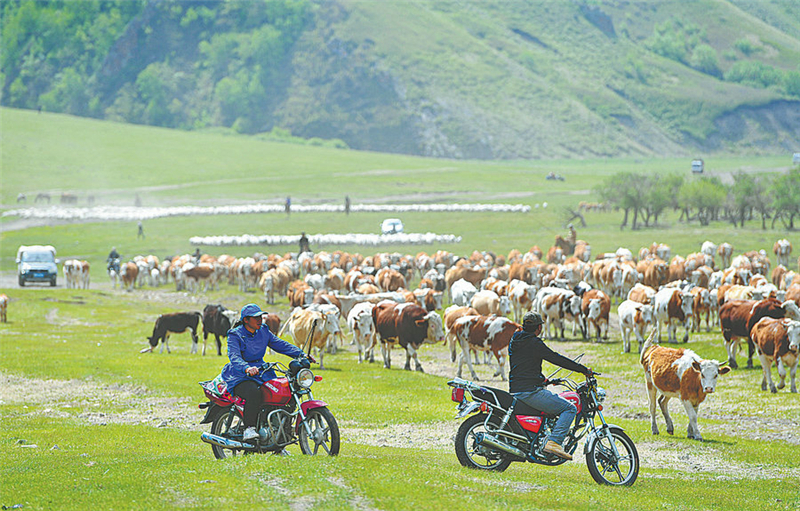
Modern vehicles facilitate seasonal movement, but also bring new challenges. [Photo provided to China Daily]
A balance with nature
The Ar Horqin Grassland Nomadic System has a healthy ecosystem and a good landscape, according to Liu Moucheng, an associate researcher with the Institute of Geographic Sciences and Natural Resources Research, Chinese Academy of Sciences, who is a co-drafter of bidding documents seeking GIAHS status.
"The heritage site has a variety of ecosystems, such as forests, grasslands, wetlands, rivers, and so on, each with important ecological functions," he points out.
"The forests and shrubs on the hillside can conserve water, and, in conjunction with the surface runoff formed by precipitation, have the functions of nourishing grasslands, promoting nutrient cycling and ensuring the domestic water of herdsmen," Liu further explains. "Grassland vegetation can also prevent wind erosion and fix sand encroachment, conserve water and soil, and provide life-sustaining habitats."
The seasonal movement of herds among different pastures plays an important role in maintaining the self-renewal and recovery capacity of the grasslands, and the nomadic lifestyle can protect vegetation and make rational use of water resources, while keeping soil fertility from degrading, Liu adds.
Chuluunbagana, the head of Bayan-Undur sum, says: "Within the summer pastures, we rotate different grazing spots. We start from somewhere higher up on the hill, or farther away from our camps. Grass there is flourishing at first. Then, we gradually approach toward our camps.
"We can thus leave enough time for the grass to take a rest and grow," he says.
However, the growing population of not only people, but also livestock, still puts unprecedented pressure on the grassland resources. Locals have, therefore, devised ways to avoid overgrazing. As ancestral wisdom is rooted in an era of relatively small societies, it may be unable to solve issues today. This is where modern planning can help.
For example, after scientific evaluation, since 2015, the number of sheep and goats in the nomadic system has been reduced from 390,000 to 190,000, following the guidance of the local government of Ar Horqin Banner, while cattle has been increased from 40,000 to 81,000 head. No more than 100,000 sheep are allowed to migrate to the summer camps every year.
More herding families have switched to using motorcycles during migration and grazing and, consequently, the grasslands are coming under new, different pressures than before.
"We've always taken measures to restore the ecology along the seasonal movement routes," Chuluunbagana says. "And more herdsmen are also being ushered into previously lesser-grazed pastures, farther away from road and water sources. This way, they can maintain a more balanced relationship with the grass."
He is glad to see that horse riding is still crucial in grazing, particularly in rugged areas. In many people's eyes, horses, which have been a key part of Mongolian history and culture, are irreplaceable in the nomadic system.
"We love motorcycles," Tsetseg, a local herdsman, says. "But if grass is continuously rolled over by wheels, it will stop growing. So motorcycles can only be our assistants. Horses will always be our closest friends."
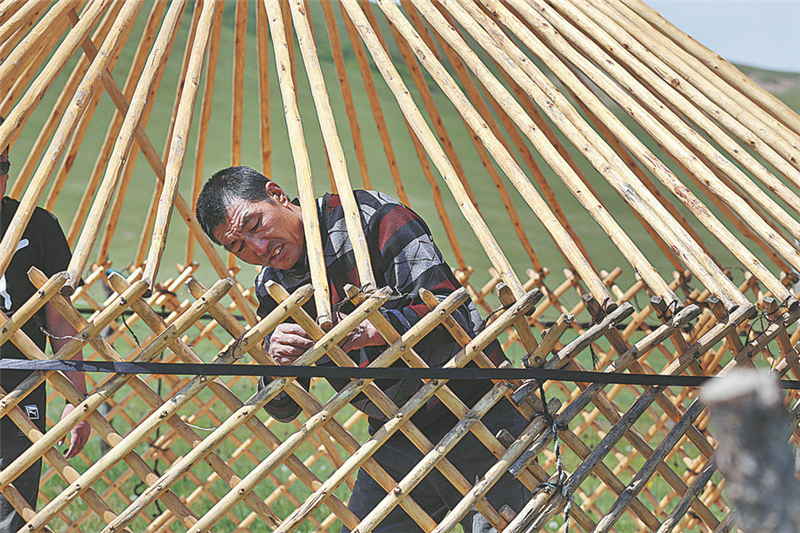
A herdsman builds a yurt. Scientifically designed grazing patterns ensure sustainable development of the grasslands. [Photo provided to China Daily]
Future blueprint
The traditional culture-a nomadic lifestyle, horse racing, archery, and elaborate wedding ceremonies-is still evident.
"Making a campfire, we can enjoy a whole summer," Oyunbileg says. "We can both cook and provide heat. I'll climb the hill and pick some wild herbs and vegetables. Life is cozy in our spare time."
Naadam, the annual traditional Mongolian festival of sports and games on the grassland, has provided the herdsmen with the most enjoyable of summer memories.
However, as the older generation fades away, Oyunbileg is concerned about how much longer this cultural heritage will last. His parents no longer participate in the regular seasonal movement because of their age.
"But they still come to the summer camp from time to time for a sense of nostalgia," Oyunbileg says. "Sometimes, I also imagine my future years when I get old. I think it may be difficult for my children to stick (to this lifestyle)."
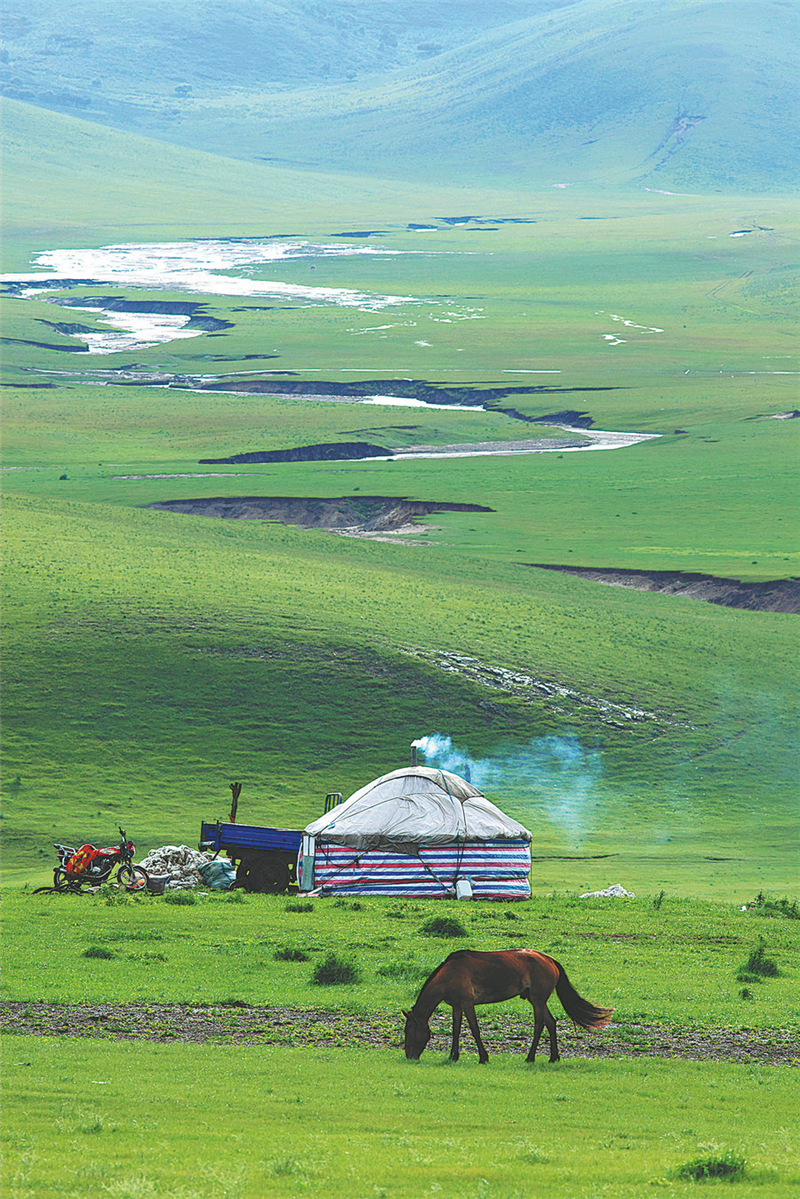
A summer home on the grassland. [Photo provided to China Daily]
Bayart grew up in Bayan-Undur sum. He is now a student at a college in Hohhot, capital of the Inner Mongolia autonomous region, which is about 1,000 kilometers away. Since he left home to study, he has not joined the seasonal movement for several years, up until now.
Because of the COVID-19 pandemic, Bayart has been doing online courses at home, enabling him to follow his family again and relive his childhood experiences this year.
"The happiest thing in summer is to have a lot of rain," he says. "That means the grass will thrive.
"It's exciting to see the grand scene when all the goats and cattle move together," he says. "Sometimes, our livestock gets mixed with that of others. The animals can be hard to recognize, but neighbors will always find a way and return them. It still feels nice to recall those days.
"However, I think I'll look for a job elsewhere," he adds. "I also think it's important to bring our culture to more people around the world. My younger brother says he'll come back, though. If we can protect our heritage, our livestock will travel much further (in the world market)."
Ar Horqin is now one of the few places in Inner Mongolia where traditional seasonal movements are still preserved as they were in the old days. Getting GIAHS status will greatly improve people's consciousness of tradition and encourage more ideas for sustainable development, according to Wang Zhiwei, director of the agricultural heritage protection center of Ar Horqin Banner.
"Improving the income of herdsmen through ecological agriculture is also an important solution," Wang says. "Nomadic life needs to catch up with the times."
Oyunbileg likes shooting short videos of his nomadic lifestyle and picturesque scenes of his hometown to post on his social media accounts.
"I'd like more people to know about our hometown," he says. "I'm also thinking of running a homestay on the grassland for tourists. When more opportunities are created here to promote our culture, some of the young people will surely return."



 Print
Print Mail
Mail


